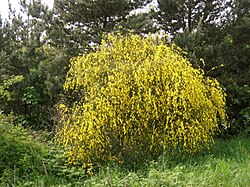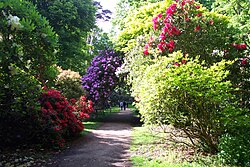**Shrub Characteristics:**
– Definition: Shrubs are perennial woody plants with persistent woody stems above ground, distinguished from trees by their height and multiple stems.
– Botanical Structure: Shrubs are woody plants less than 8 meters high with multiple stems, categorized based on height and foliage cover.
– Subshrubs: Small, low shrubs less than 2m tall, often without a main trunk below ground.
– Deciduous vs. Evergreen: Shrubs may be deciduous or evergreen, with some reaching heights of 2-8 meters in closed-shrub or tall shrubland forms.
**Shrub Use in Gardens and Parks:**
– Cultivation: Shrubs in gardens are mainly broad-leaved plants, cultivated in parks or gardens as shrubberies.
– Pruning Techniques: Renewal pruning can lead to long new stems known as canes, and selective pruning can reveal the structure and character of shrubs.
– Topiary: Some shrubs can be clipped as topiary for dense foliage in garden settings.
**Literature References on Shrubs:**
– Lawrence and Hawthorne (2006) on plant identification.
– Allaby (2019) on plant sciences.
– McCabe’s Landscape Construction on life spans of small trees and shrubs.
– Clayton (2021) on the classification of the coffee plant.
– Bremness (1994) on the complete book of herbs.
**Culinary Usage of Shrubs:**
– Limited Usage: Few shrubs have direct culinary uses, with some perfumed species like lavender and rose having culinary and medicinal applications.
– Tea and Coffee Plants: These plants fall on the tree-shrub boundary, with most shrubs not used for timber due to their small size.
– Comparison: Culinary usage of shrubs is limited compared to trees and herbs.
**Types and Characteristics of Trees:**
– Deciduous Trees: Include oak, maple, birch, poplar, and elm, shedding leaves annually and grown in temperate regions.
– Evergreen Trees: Include pine, spruce, cedar, fir, and juniper, retaining leaves year-round and adapted to cold climates.
– Benefits: Deciduous trees provide shade in summer, habitat for wildlife, aesthetic value, oxygen production, and soil erosion prevention.
This article needs additional citations for verification. (October 2018) |
A shrub or bush is a small-to-medium-sized perennial woody plant. Unlike herbaceous plants, shrubs have persistent woody stems above the ground. Shrubs can be either deciduous or evergreen. They are distinguished from trees by their multiple stems and shorter height, less than 6–10 m (20–33 ft) tall. Small shrubs, less than 2 m (6.6 ft) tall are sometimes termed as subshrubs. Many botanical groups have species that are shrubs, and others that are trees and herbaceous plants instead.


Some define a shrub as less than 6 m (20 ft) and a tree as over 6 m. Others use 10 m (33 ft) as the cutoff point for classification. Many trees do not reach this mature height because of hostile, less than ideal growing conditions, and resemble shrub-sized plants. Others in such species have the potential to grow taller in ideal conditions. For longevity, most shrubs are classified between perennials and trees. Some only last about five years in good conditions. Others, usually larger and more woody, live beyond 70. On average, they die after eight years.
Shrubland is the natural landscape dominated by various shrubs; there are many distinct types around the world, including fynbos, maquis, shrub-steppe, shrub swamp and moorland. In gardens and parks, an area largely dedicated to shrubs (now somewhat less fashionable than a century ago) is called a shrubbery, shrub border or shrub garden. There are many garden cultivars of shrubs, bred for flowering, for example rhododendrons, and sometimes even leaf colour or shape.
Compared to trees and herbaceous plants, a small number of shrubs have culinary usage. [citation needed] Apart from the several berry-bearing species (using the culinary rather than botanical definition), few are eaten directly, and they are generally too small for much timber use unlike trees. Those that are used include several perfumed species such as lavender and rose, and a wide range of plants with medicinal uses. Tea and coffee are on the tree-shrub boundary; they are normally harvested from shrub-sized plants, but these would be large enough to become small trees if left to grow instead.
English
Pronunciation
- (UK, US) enPR: shrŭb, IPA(key): /ʃɹʌb/
- Rhymes: -ʌb
Etymology 1
From Middle English schrub, schrob, (also unassibilated as scrub), from Old English *sċrob (in placenames) and sċrybb (“a shrub; shrubbery; underbrush”); akin to Norwegian skrubbe (“the dwarf cornel tree”).